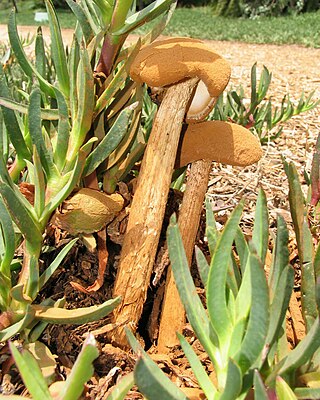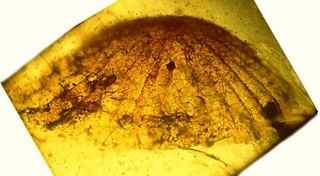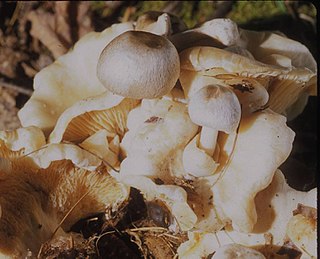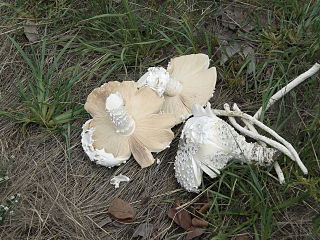
Neolentinus ponderosus, commonly known as the giant sawgill, or ponderous lentinus, is a species of fungus in the family Gloeophyllaceae. Found in western North America, it was originally described in 1965 as a species of Lentinus by American mycologist Orson K. Miller.

Termitomyces, the termite mushrooms, is a genus of basidiomycete fungi belonging to the family Lyophyllaceae. All of which are completely dependent on fungus-growing termites, the Macrotermitinae, to survive, and vice versa. They are the food source for these termites, who enjoy an obligate symbiosis with the genus similar to that between Atta ants and Attamyces mushrooms. Termitomyces mushrooms are edible, and are highly regarded for their flavor.

Agaricus bernardii, commonly called the salt-loving agaricus, or salt-loving mushroom, is an agaric fungus in the family Agaricaceae. The mushroom's thick stem is usually shorter than the diameter of the cap, which ranges from 5–15 centimetres and is convex to flattened. The cap surface is whitish to buff, and can develop scales or warts in age. The gills are initially pink before turning brown when the spores mature. The flesh turns reddish when it is cut or bruised. It resembles species such as A. bitorquis.

The Macrotermitinae, the fungus-growing termites, constitute a subfamily of the family Termitidae that is only found within the Old World tropics.

Podaxis pistillaris is a very distinctive relative of the puffballs. It is commonly known as the desert shaggy mane, as it bears a superficial resemblance to the shaggy mane, Coprinus comatus; this species lacks the latter's deliquescing gills, however, and the two are not closely related. It grows to 15 cm high and has a hard, woody stem. The large cap, which protects the blackish spore-bearing tissue, splits, and usually falls away at maturity, allowing the spores to be dispersed by wind. Large numbers may appear after soaking rains. It thrives in deserts and semi-deserts of Australia and other countries, often found on termite mounds in South Africa. In the Hawaiian Islands, it is frequently encountered along roadsides and in disturbed areas on the dry sides of the islands, especially in the Kona area of Hawaii and the Kihei area of Maui.

Battarrea phalloides is an inedible species of mushroom in the family Agaricaceae, and the type species of the genus Battarrea. Known in the vernacular as the scaley-stalked puffball, sandy stiltball, or desert stalked puffball, it has a woody, slender, and shaggy or scaly stem that is typically up to 40 centimeters (15.7 in) in length. Although its general appearance resembles an agaric with stem and gills, atop the stem is a spore sac, consisting of a peridium and a powdery internal gleba. In maturity, the spore sac ruptures to release the spores. Battarrea phalloides is found in dry, sandy locations throughout the world, and has been collected from Africa, Asia, Australia, Europe, North America, and South America. There is currently some disagreement in the literature as to whether the European B. stevensii is the same species as B. phalloides.
Macrolepiota albuminosa is a species of agaric fungus in the family Agaricaceae, found in Peradeniya, Ceylon.

Galerina sulciceps is a dangerously toxic species of fungus in the family Strophariaceae, of the order Agaricales. It is distributed in tropical Indonesia and India, but has reportedly been found fruiting in European greenhouses on occasion. More toxic than the deathcap, G. sulciceps has been shown to contain the toxins alpha- (α-), beta- (β-) and gamma- (γ-) amanitin; a series of poisonings in Indonesia in the 1930s resulted in 14 deaths from the consumption of this species. It has a typical "little brown mushroom" appearance, with few obvious external characteristics to help distinguish it from many other similar nondescript brown species. The fruit bodies of the fungus are tawny to ochre, deepening to reddish-brown at the base of the stem. The gills are well-separated, and there is no ring present on the stem.

Amanita regalis, commonly known as the royal fly agaric or the king of Sweden Amanita, is a species of fungus in the family Amanitaceae. A. regalis has a scabby liver-brown cap and a stem which is yellow-ochre at the base, with patches or rings of patches. The fruit bodies somewhat resemble the smaller A. muscaria, which it was formerly regarded as a variety of.

Palaeoagaracites is an extinct monotypic genus of gilled fungus in the order Agaricales. It contains the single species Palaeoagaracites antiquus.

Volvariella surrecta, commonly known as the piggyback rosegill, is an agaric fungus in the family Pluteaceae. Although rare, the species is widely distributed, having been reported from Asia, North America, Northern Africa, Europe, and New Zealand. The fungus grows as a parasite on the fruit bodies of other gilled mushrooms, usually Clitocybe nebularis. V. surrecta mushrooms have white or greyish silky-hairy caps up to 8 cm (3.1 in) in diameter, and white gills that turns pink in maturity. The stipe, also white, is up to 9 cm (3.5 in) long, and has a sack-like volva at its base.

Psathyrella ammophila is a species of fungus in the family Psathyrellaceae and is found throughout Europe. Commonly known as the dune brittlestem, this agaric primarily grows on sand dunes near marram grass, feeding saprotrophically on the decaying roots. The season of growth is generally May to November.

Termitomyces le-testui is a species of agaric fungus in the family Lyophyllaceae. It was first described scientifically from Africa by French mycologist Narcisse Théophile Patouillard in 1916, and transferred to the genus Termitomyces by Roger Heim in 1942. The mushroom is edible and used as food.

Termitomyces tylerianus is a species of agaric fungus in the family Lyophyllaceae. Found in Africa and China, it was first formally described in 1964. Fruit bodies (mushrooms) grow in groups or clusters near termite nests in deciduous forests. The mushrooms are edible.

Termitomyces microcarpus is a species of agaric fungus in the family Lyophyllaceae. An edible species, it is found in Africa and Asia, where it grows in groups or clusters in deciduous forests near the roots of bamboo stumps associated with termite nests.

Termitomyces heimii is a species of agaric fungus in the family Lyophyllaceae. It has symbiotic relationship with termites. Described as new to science in 1979, it is found in India. The specific epithet heimii honors French mycologist Roger Heim. The fruit bodies (mushrooms) produced by the fungus are edible.

Termitomyces schimperi is a large mushroom associated with the termite species Macrotermes michaelseni. It grows in the northern part of Southern Africa, from northern Namibia up to Democratic Republic of Congo (DRC), eastwards to Malawi and Mozambique, and westwards to Ivory Coast.

Mycena purpureofusca, commonly known as the purple edge bonnet, is a species of agaric fungus in the family Mycenaceae. First described by Charles Horton Peck in 1885, the species is found in Europe and North America, where it grows on the decaying wood and debris of conifers, including cones. Fruit bodies have conical to bell-shaped purple caps up to 2.5 cm (1 in) set atop slender stipes up to 10 cm (4 in) long. The mushroom is named for the characteristic dark greyish-purple color of its gill edges. In the field, M. purpureofusca mushrooms can usually be distinguished from similar species by characteristics such as the dark purple gill edges, the deep purple cap center, and its cartilagineous consistency. The fungus contains a laccase enzyme that has been investigated scientifically for its potential to detoxify recalcitrant industrial dyes used in textile dyeing and printing processes.

Macrotermes is a genus of termites belonging to the subfamily Macrotermitinae and widely distributed throughout Africa and South-East Asia. Well-studied species include Macrotermes natalensis and M. bellicosus.

Macrocybe crassa is a species of fungus that is native to Sri Lanka, India (Kerala), Thailand and Malaysia. The large pale cream to brownish mushrooms can weigh up to 1.25 kg and have 40 cm diameter caps. They are widely consumed and highly regarded.


















